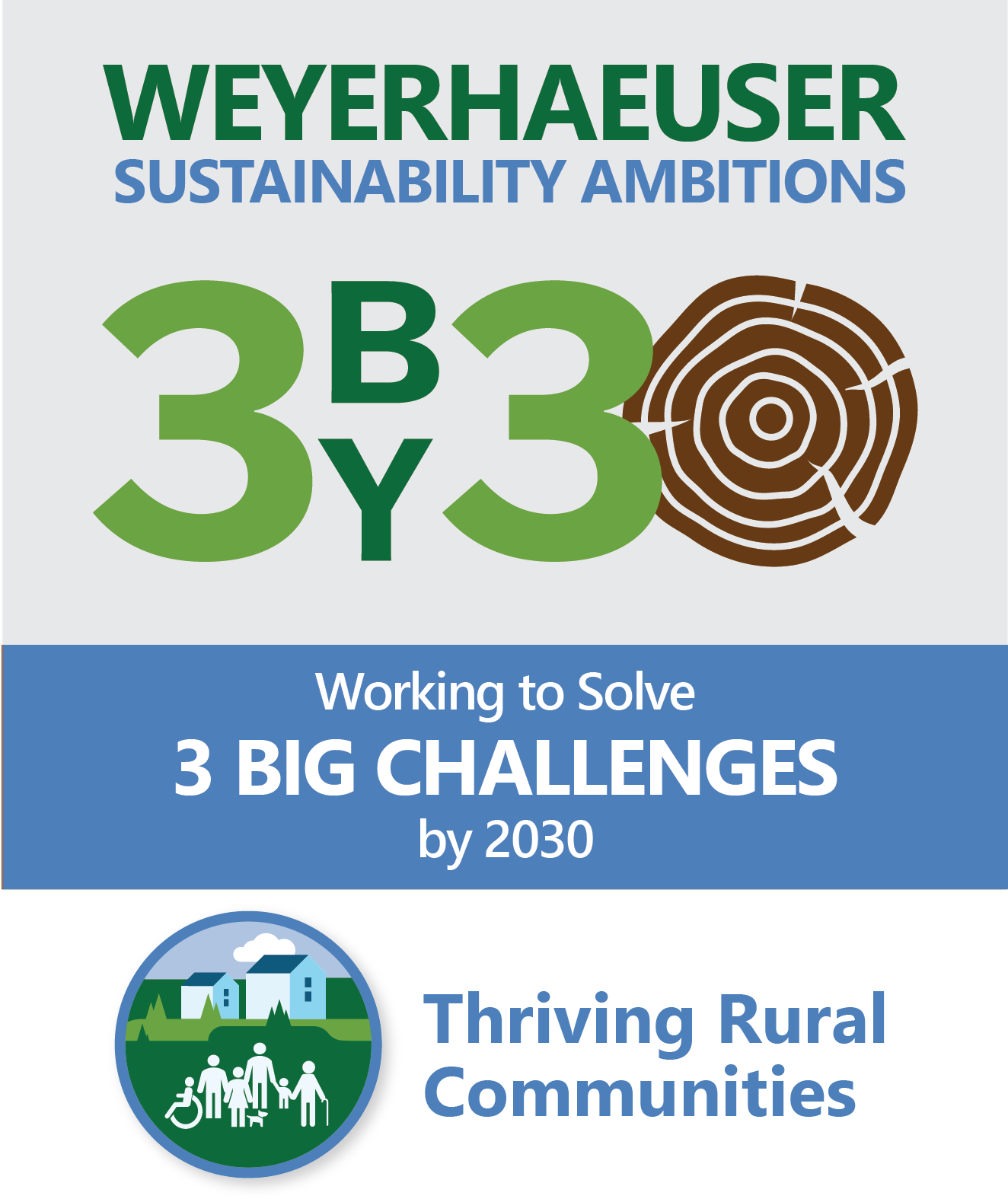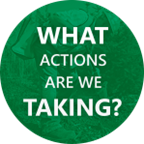 Communities
Communities
We help make our rural communities thriving places to work and live
WHAT IS THE CHALLENGE?
Most of our employees live in rural communities across North America where our mills, distribution centers, timberlands and other offices are located. These small towns are often built around a history of forestry and manufacturing as well as a deep appreciation for outdoor activities and experiences closely tied to forests.
Society at large benefits from thriving rural communities and landscapes because they are often crucial sources of water, food, energy and recreation for all people, no matter where they live.
In some rural areas, however, the barriers to economic and social prosperity can be difficult to overcome, particularly in communities that lack access to good job opportunities, are experiencing population declines or other demographic shifts. According to many reports, the lasting negative effects of the Great Recession disproportionately affected rural areas, and the COVID-19 pandemic significantly impacted rural well-being. A declining population in these areas is both the cause and effect of limited employment opportunities. Education, technology and infrastructure are often underfunded, especially for communities of color and other marginalized people, and rural communities often experience limited access to critical services such as healthcare and higher education.

WHAT IS OUR ROLE?
As a company with operations in many rural areas, we play a significant role by providing family-wage jobs with opportunities for growth, a stable tax base, recreational access to our land and philanthropic support to local organizations. Our employees are also extremely active volunteers for causes they care about, and many are engaged in civic leadership or are otherwise part of the fabric of these communities.
At the same time, we are acutely aware of the challenges these communities face, and we are motivated to help ensure they remain great places to live, work and do business for decades to come.
We believe permanent and successful solutions can be found through the right combination of focus, resources and leadership, supported by public and private partnerships as well as grassroots organization and engagement. Nobody is better equipped to chart a future for a community than the people living and working there every day, so we aim to leverage our resources and experience to participate in initiatives that support those local priorities.
WHAT DO WE WANT TO ACHIEVE BY 2030?
By 2030, we envision real, measurable improvements in how we, and those we partner with, ensure rural communities are great places to live, work and do business. We view the health and vibrancy of our communities as integral to our long-term success as a company, and we expect to drive meaningful growth in how we engage with, invest in and otherwise support our operating areas.
WHERE WE ARE FOCUSED FOR PHASE 2 (2023 – 2025)?
While there is much we can accomplish over a decade, we have structured our long-term goals into three-year phases to effectively prioritize and accelerate progress. Currently, we are two-thirds of the way through the second phase of our 3 by 30 Communities Sustainability Ambition – running from 2023 to 2025 – and are focusing our work in two key areas:
1. Investing targeted resources to ensure our rural communities are healthy and resilient
While we already have a robust corporate giving program that directly benefits our communities, we know we can do more to direct our resources to the highest-priority issues in the areas where we operate.
2. Leveraging our scale, voice and influence to help solve critical rural challenges through advocacy efforts
By partnering with government agencies, other companies, nonprofits and community leaders, we can better identify and advocate for the needs of rural communities and ensure resources are directed toward the highest-impact areas.
Actions include: building broad support for our partner organizations; continuing to advocate for investment in broadband expansion; supporting our partner organizations’ state and federal funding requests; and aligning industry peers and trade associations on workforce development issues.
PHASE 2 ACCOMPLISHMENTS
During the second phase of our 3 by 30 Sustainability Ambitions, we are intentionally making fewer, but more strategic, investments of our time and resources. While much of our Phase 2 work is ongoing, we have already achieved several important milestones:
- The announcement of our THRIVE program to provide targeted support to five of our rural operating communities. Each community will receive an investment of $1 million from Weyerhaeuser over the next several years.
- We selected Zwolle and the northwest Louisiana region as our first THRIVE community. Working with local elected officials and community leaders, our team determined four strategic project areas to maximize the program’s positive impact: water infrastructure, education, recreation and the economy.
- Water: We completed a water system analysis in Zwolle, supported grant applications with matching fund commitments, and secured support from elected leaders to promote grant requests.
- Education: We launched partnerships with the local school district and United Way of NW Louisiana to improve literacy rankings in Sabine Parish, participated in two targeted outreach events for Dolly Parton’s Imagination Library, and established a new partnership with Oklahoma State University Institute of Technology to expand a workforce development scholarship training program to graduating seniors.
- Recreation: We are partnering with Zwolle Dixie Youth to improve recreation infrastructure in the community.
- Economy: We partnered with the Center on Rural Innovation (CORI) to aid Natchitoches, Louisiana, in the creation of a five-year, technology-based economic development plan.
- We selected Raymond, Washington, as our second THRIVE community and began working with elected officials and community leaders to identify key needs and priorities.
- We launched and grew our “Learn Local, Earn Local” program to support workforce development and youth education in our rural operating communities. We awarded additional funds to each of our local Giving Fund Advisory Committees to support efforts in their areas; expanded national partnerships with organizations such as Project Learning Tree, Be Pro Be Proud and Jobs for America’s Graduates; participated in Pathways 2 Possibilities in Mississippi and South Carolina; launched a new partnership with Skills Canada; and engaged employees in youth education activities.
- We grew our Fighting Fires Together campaign, developed in partnership with the Firefighter Behavioral Health Alliance (FBHA), to provide specialized mental-health support and resources to wildland firefighters.
- We launched a fall giving campaign in 2024 focused on a “Tools for Schools” supply drive supporting six organizations in our operating areas, and our employees delivered 125 “Goods from the Woods” boxes to schools in our operating communities.
- We continued our partnership with Habitat for Humanity International, completing two additional local housing builds in 2024, to go with the three builds we completed in 2023. Builds were completed in Monroe, Louisiana (two); Moncks Corner, South Carolina; and Hot Springs, Arkansas (two).
FOUNDATIONAL SUCCESSES FROM PHASE 1 (2020 – 2022)
In the first phase of our work to achieve our 3 by 30 Sustainability Ambitions, we laid the groundwork for meaningful progress toward our goals. We accomplished 70 percent of the action items we set out to achieve; remaining actions were rolled into Phase 2 or set aside in favor of more effective tactics.
Key Accomplishments
In 2021, we held our first annual education session with our regional employee-led Giving Fund Advisory Committees to ensure they had the tools and resources they needed to effectively make local giving decisions.
We also established an internal taskforce focused on supporting our rural communities with participation from all businesses, local leadership and corporate functions. This team helped establish key priorities and ensured the perspectives of staff and business groups were included in planning.
We formed a partnership with American Forests to develop tree planting and workforce development pilot programs in three of our rural – or smaller urban – communities. In 2022, we held a planting event in Ruston, Louisiana, with Louisiana Tech University and a local urban forestry organization. In addition, teachers at Ruston High School began implementing a newly created curriculum focused on green careers and urban forestry, with 200 students participating.
We also worked with American Forests to bring its Tree Equity Score Analyzer to smaller urban and rural areas. American Forests launched its beta Tree Equity Score Analyzer application in Ruston and is using it to calculate the impact from the planting event to demonstrate the tool’s applicability in other rural and small urban areas.
We expanded our partnership with Habitat for Humanity International to support more than 10 local housing builds in or near our communities. Eight builds were completed in 2022: Lane County, Oregon; Cowlitz County, Washington; Grays Harbor County, Washington; Northern Louisiana; Central Oregon; Garland County, Arkansas; Wilmington, North Carolina; and Flathead Valley, Montana.
We participated in “Habitat on the Hill” advocacy for rural communities through our enhanced Habitat for Humanity partnership.
By using this website, you agree to our Privacy Policy. California residents: See our CCPA Privacy Notice for details on what personal information we collect and for what purposes.



